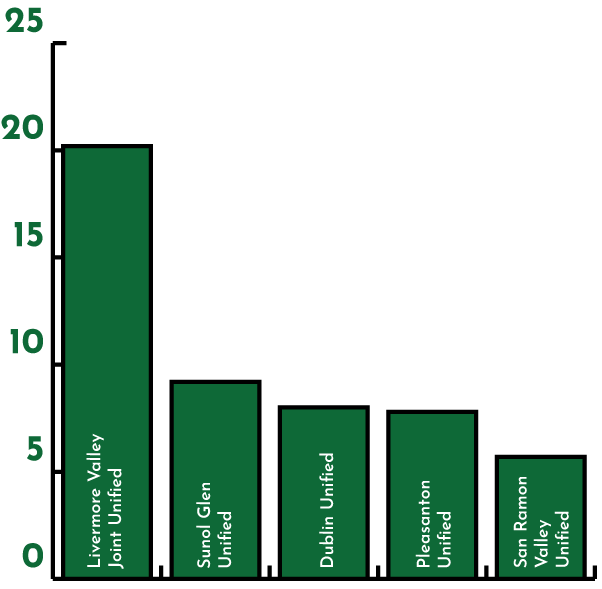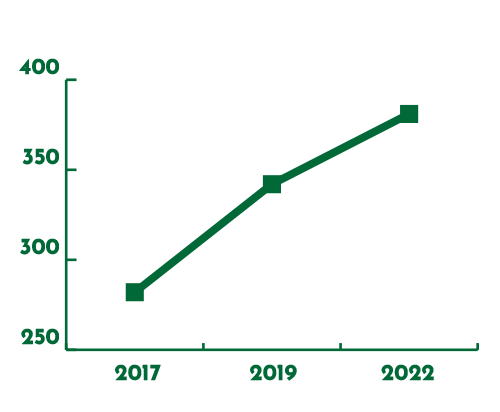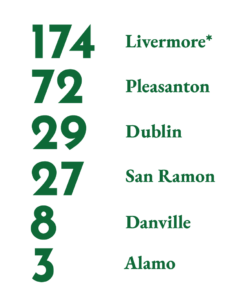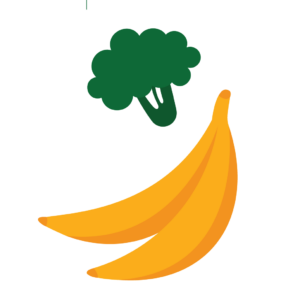Community Need
We work directly with individual donors, corporations, nonprofits, community and government leaders who desire to make a positive impact on our Tri-Valley region.
The Tri-Valley is a thriving hub in the greater SF/East Bay geographical region – with a GDP of over $40 billion. Yet only 0.5 percent of that stays local via philanthropy. When that figure is compared to the national average of 1.5-2 percent, that natural question is why? And what can be done to change this? There are over 300 local nonprofits on the front lines in our community – working to serve the Tri-Valley region. They deserve our support. Three Valleys Community Foundation works to increase the percentage of local wealth given directly to address local needs.
By the Numbers
A Glimpse at the Need in Our Three Valleys Region
Our Three Valleys region is rich in innovation, scientific and technical achievements, agriculture, natural beauty, and the arts, with a strong commitment to inclusion and community. Yet submerged in our suburbs and in the midst of great affluence, there are many individuals struggling to survive daily.
Whether that struggle comes in the form of food security, housing, access to basic health or mental health services, the needs and the individuals are very real. Here are just a few examples…
Top Community Health Needs
The 2022 Community Health Needs Assessment (CHNA) by John Muir Health, along with the 2021 CHNA and the 2019 Community Benefit Report by Stanford Health Care Tri-Valley, cite behavioral (mental) health, structural racism, economic security, housing and homelessness, healthcare access and delivery, community and family safety, food security and transportation, and healthy lifestyles as the top Tri-Valley community health needs. ¹
Poverty
More than 16,400 individuals live below the poverty line in our Three Valleys region. That represents a 60% increase in the number of people living in poverty since 2000.²

Poverty in our Schools
In our Three Valleys region, there are approximately 6,500 school-aged youth who live in socio-economically disadvantaged households.³

Housing
11,000 Tri-Valley households are rent-burdened (over 30% of income goes to rent).4

Unsheltered Individuals5


*In addition, Livermore has 68 sheltered homeless individuals, 48% of whom are children.
Food Insecurity

More than 185,500 residents in Alameda and Contra Costa Counties are food insecure. 70,000 are children.6
Transportation
Rates of extreme commuting (>90 minutes one way) are twice as high for Dublin residents compared to Alameda County (11% vs 5%). Rates are also higher in Pleasanton and Livermore than the Alameda County average (7% vs 5%).7
Foster Youth
There are nearly 75 identified foster youth who live in our Three Valleys region.8
Childcare
In Alameda County, more than 115,000 children lack access to formal childcare and early education/preschool.9
Mental Health
According to worldwide trends, since the pandemic, 1 in 4 youth are experiencing elevated depression symptoms and 1 in 5 elevated anxious systems; in the Tri-Valley, mental health is a crisis across all populations, with an increase in youth suicide attempts, suspensions, and behavioral issues.10
Education

Join Three Valleys Community Foundation as we identify the top needs in our region for grantmaking opportunities in 2023. Our goal? A community where every single person has the opportunity to live a full and rewarding life. Let’s give, grant and grow – together.
Sources: 1 Community Health Needs Assessment, John Muir Health Report (2022) **Alameda and Contra Costa Counties Hospital CHNA Group: John Muir Health, Sutter Health, St. Rose Hospital, Stanford Health Care Tri-Valley, UCSF Benioff Children’s Hospitals. Partners: Kaiser Permanente, Alameda County Public Health Department, Contra Costa Health Services. Community Health Needs Assessment, Stanford Health Care – ValleyCare, Actionable Insights, LLC., (2019); Community Benefit Report, Stanford Health Care – ValleyCare, Community Benefit Advisory Group, (2021). 2 U.S. Census Bureau, Poverty, Poverty Thresholds, (2020); Data Profile: Just Getting By in the Tri-Valley, Tri-Valley Anti-Poverty Collaborative and Alameda County-Oakland Community Action Partnership, (August 2021). 3 DataQuest, California Department of Education, (2020). 4 Data Profile: Just Getting By in the Tri-Valley, Tri-Valley Anti-Poverty Collaborative and Alameda County-Oakland Community Action Partnership, (August 2021). 5 Everyone Counts! Homeless Point-in-Time Count, Alameda County and Contra Costa County, (2022). 6 Gundersen, C., Strayer, M., Dewey, A., Hake, M., & Engelhard, E., Map the Meal Gap 2022: An Analysis of County and Congressional District Food Insecurity and County Food Cost in the United States in 2020. Feeding America, (2022) 7 Community Health Needs Assessment, John Muir Health Report (2022). 8 DataQuest, California Department of Education, (2020). 9 Alameda County Early Care and Education Needs Assessment, Cities Profiles, Alameda County Early Care and Education Planning Council / First 5 Alameda County, (2021) 10 Racine, N. et al., Global Prevalence of Depressive and Anxiety Symptoms in Children and Adolescents During COVID-19, A Meta-analysis. JAMA Pediatr., (2021). Community Health Needs Assessment, John Muir Health Report (2022) 11 Community Health Needs Assessment, Stanford Health Care – ValleyCare, Actionable Insights, LLC., (2019); Data Profile: Just Getting By in the Tri-Valley, Tri-Valley Anti-Poverty Collaborative and Alameda County-Oakland Community Action Partnership, (August 2021).
